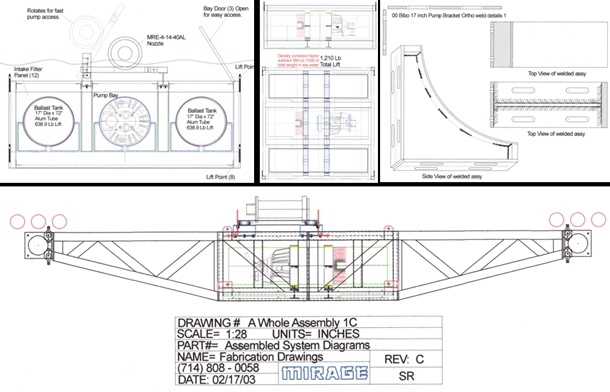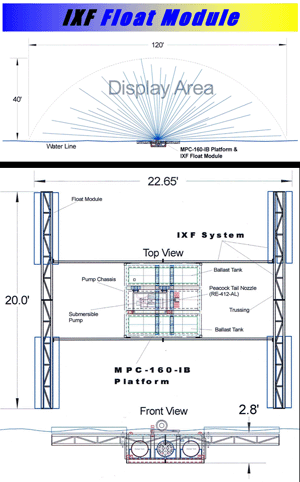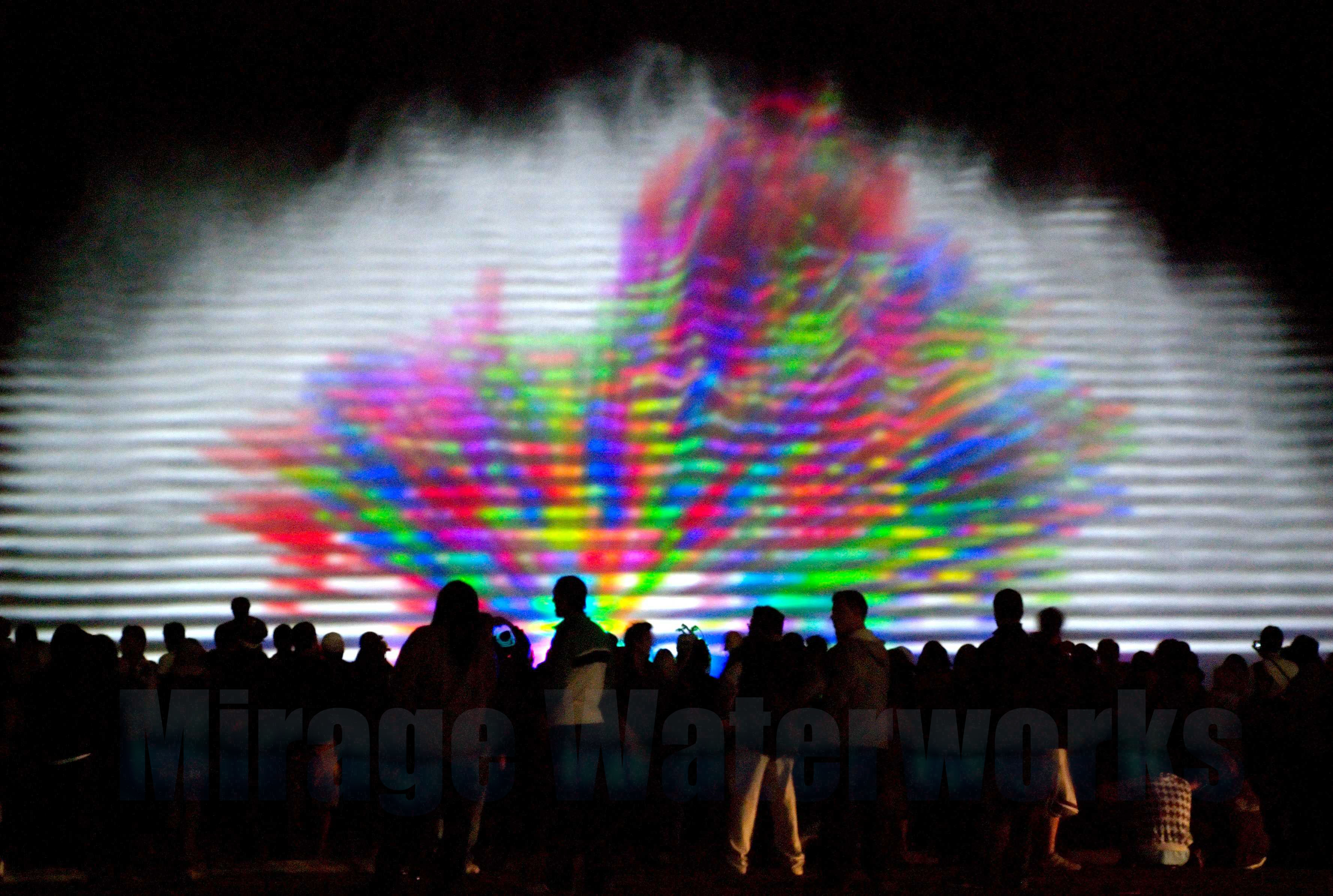The Invention of the Multi Pump Chassis Peacock Tail Water Screen System
An exercise in using submarine technology to create a water screen system that would alleviate the need for barges, platforms and other unsightly industry standard support rigs.
We had been working on a pet project that was on the back burner for some time. The WaterScrim™ systems had taken most of our resources for the last several years, but, it was cruising along nicely and we finally had time to focus our development energy on a different project. We had been throwing ideas around about what the ultimate peacock tail water screen system would be. Because we were so busy with other development work the Ultimate PT project had amounted to little more that idea jam sessions and pie in the sky brainstorming. By mid 2003 our ideas were starting to take shape and a concept was borne. We had actually done a lot of refinement work on it while it was still in the conceptual phase. Over time we had found that exercising a new system on paper as much as is possible saves a lot of wasted time in prototype development as well as a lot of development money.
prototype development as well as a lot of development money.
There were only a handful of companies in the world doing peacock tail water screen shows at the time and the systems we had seen were fairly primitive. Most of them used some type of barge or floating dock like structure to support the water screen pumps and nozzle. This produced a large unsightly structure for these shows that, by nature of projection geometry, the audience is looking straight at. We thought the whole mess should lie under the water so it didn’t interfere with the aesthetics of the display area. The system would be used in both shallow water and deep water venues, It would need adjustable legs for the shallow water applications and an External Flotation Module for deep water.
We also wanted a design that would be flexible so that it could be readily re-configured to match the different performance requirements from one show/display to the next. It would have to be capable of accepting different types and different numbers of pumps, pump configurations as well as different nozzles. There were also thoughts of integrating large scale fountain effects on the same chassis.
If we were going to build a rental system the design would have to be streamlined so that it was totally portable, fast and easy to load-in and strike. It needed to be configured so it could be launched and recovered using several different methods as would be the case at different water based venues. Methods discussed were, a trailer/boat ramp, a forklift and straps, a crane & straps, and, a launch ramp & dollies.
The system would have to be able to filter water at an immense rate (1200 Gallons per minute) as it would eventually be required to perform in bodies of water that were less than clean. The filtration system would have to be capable of ingesting a great deal of debris some of which might be as large as a trash bag, without becoming plugged.
We arrived at a design based on a low profile chassis with pumps inside and the nozzle mounted on top. It needed to be low profile so it could perform in venues with minimal water depth. The chassis contains ballast tanks so it can accommodate different pump payloads and still be trimmed to a neutral buoyancy. This would also allow it to be floated into place then sunk to its submerged show state. It employs 3 bays each of which can accommodate either pumps, ballast tanks or fountain accessories. The 3 bays are covered by full length, full width doors for easy access to internal workings.
The system is basically a squat box. We decided that the best way to filter the massive amount of water needed to run the system was to cover the entire chassis with perforated panels. This would give us over 45 square feet of intake filtration area, so, the system was capable of filtering out objects as large as trash bags without affecting its operation. This would also reduce the velocity of water over the intake gratings to a rate that would prevent even the meekest marine life from being trapped on the grates. Each of these grating panels was made removable for cleaning and complete access to the internal workings. We mounted the nozzle to a removable bracket with a kinematic base, so, fine angular adjustments can be made to the nozzle’s output pattern. The chassis was designed with adjustable legs at each corner. This way the system could be quickly configured for different operating depths at shallow water venues.
We would need a floatation system that could be attached to the MPC for deep water applications. The MPC-160 creates between 700lb to over 1000Lb of down force during operation, so, it can be somewhat challenging keeping it all stable yet, not to obtrusive. We designed a Bi-Laterally opposed float system based on 12” lighting box truss and some custom “A” frame made of Heli-Arc’d rectangular aluminum tube . We would end up calling it the Integrated External Float System or IXF for short. It is simply assembled and attached to the MPC platform once the MPC is floating.

The MPC system was designed to be launched like a boat and floated into position. After it’s in position either the legs will be extended, then sunk by flooding the ballast tanks (if it shallow water gig, or, anchored/moored if it is a deep water gig. The power cord is simply let out from shore as the MPC is floated out into show position.
The MPC-160’s first gig would be in Hawaii. In December of 2003 Paul Medeiros of AVHQ and Jimmy Pallas of 9PM productions out of Italy, approached us about doing a water screen show for Amway in a salt water lagoon in Hawaii.
We said we had the perfect system for the job and sent them info on our brand new MPC-160. To make a long story short the system worked like a champ. We didn’t have the IXF float system finished yet, so, we just set up some scaffold on the lagoon floor and set the MPC on top of it. (Water depth was about 14’). It was one of our proudest moments watching it come to life for the first time. We didn’t have time to test it before shipping it off to Hawaii, so, along with the pride was also a lot of relief. Without time to test and refine it, I started questioning everything, the weight/buoyancy calculations, weight distribution and flow/Pressure calc’s. Was it going to sink, flip upside down or blow apart??
Well, it didn’t do any of those, it just came to life in a huge hissing wall of water. The best part was that you couldn’t see anything, just a little nozzle sticking up out of the water like a blue coffee can shaped periscope.
The MPC-160 (and Jimmi Palas’s show) was a huge hit and during rehearsals it drew a very large crowd. It was the first time anything like it had been done in Hawaii. The system ran flawlessly for 2 days and 2 nights and was loaded out by 2 persons and a forklift.
We had a fantastic time working with Paul at AVHQ, Jimmy Pallas and his A1Team at 9pm productions.
To our knowledge the MPC-160 is the only self floating peacock tail screen system of its kind in the America’s.

Mirage WaterWorks, Inc.
San Bernardino, CA 92408
ph (714) 323-0556
This email address is being protected from spambots. You need JavaScript enabled to view it.
INNOVATION ENGINEERING & DESIGN
TEMPERED with EXPERIENCE
WaterScrim™ and X-Scrim™ are a trademarks of Mirage WaterWorks Inc.
